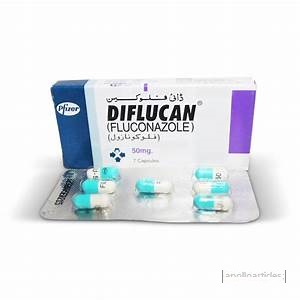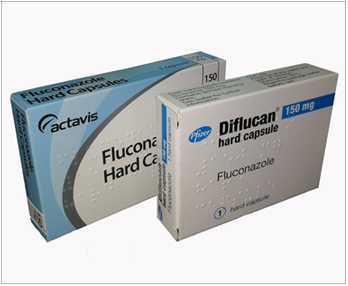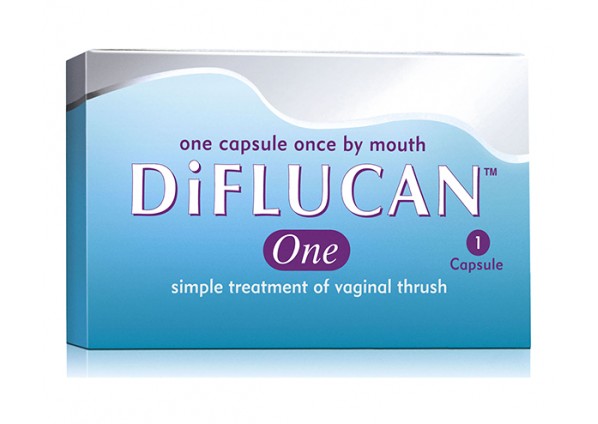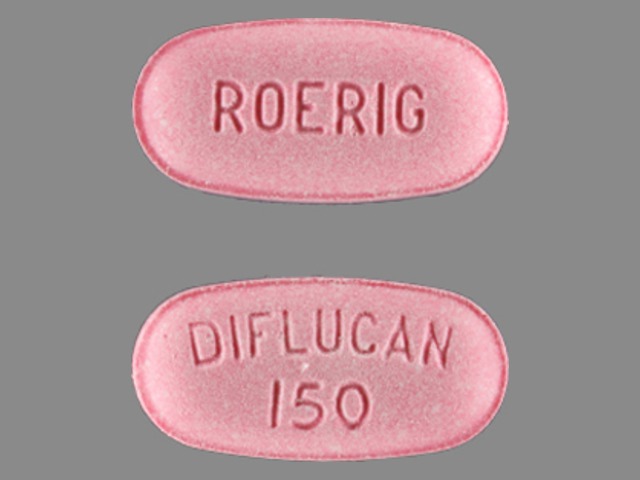
Diflucan is used for treating and preventing certain yeast and fungal infections.
$0.78 per pill
Fluconazole, a representative of the class of triazole antifungal agents, is a potent selective inhibitor of sterol synthesis in the fungal cell.
Fluconazole is active in vitro and in clinical infections against the following microorganisms: Candida albicans, Candida glabrata (many strains are moderately sensitive), Candida parapsilosis, Candida tropicalis, Cryptococcus neoformans.
Fluconazole has been shown to be active against the following microorganisms in vitro, but the clinical significance of this is unknown: Candida dubliniensis, Candida guilliermondii, Candida kefyr, Candida lusitaniae.

When taken orally, fluconazole is active in various animal models of fungal infections. Demonstrated the activity of the drug in opportunistic mycoses, incl. caused by Candida spp. (including generalized candidiasis in immunosuppressed animals); Cryptococcus neoformans (including intracranial infections); Microsporum spp. and Trichophyton spp. The activity of fluconazole was also established in models of endemic mycoses in animals, including infections caused by Blastomyces dermatitides, Coccidioides immitis (including intracranial infections) and Histoplasma capsulatum in animals with normal and suppressed immunity.
Fluconazole is highly specific for cytochrome P450 dependent fungal enzymes. Fluconazole therapy at a dose of 50 mg / day for up to 28 days does not affect the concentration of testosterone in the blood plasma in men or the concentration of steroids in women of childbearing age. Fluconazole at a dose of 200-400 mg / day has no clinically significant effect on endogenous steroids and their response to stimulation of adrenocorticotropic hormone (ACTH) in healthy male volunteers.
Mechanisms for the development of resistance to fluconazole
Resistance to fluconazole can develop in the following cases: a qualitative or quantitative change in the enzyme that is the target of fluconazole (lanosteril 14-?-demethylase), reduced access to the target of fluconazole, or a combination of these mechanisms.
Point mutations in the ERG11 gene encoding the target enzyme lead to a modification of the target and a decrease in the affinity for azoles. Increased expression of the ERG11 gene results in the production of high concentrations of the target enzyme.
The second significant mechanism of resistance is the active excretion of fluconazole from the intracellular space, causing two types of transporters involved in the active excretion (efflux) of drugs from the fungal cell. These transporters include the main mediator encoded by the MDR (multidrug resistance) genes and the superfamily of the ATP-binding transporter cassette encoded by the CDR genes (genes for resistance of Candida fungi to azoles antimycotics).
Overexpression of the MDR gene leads to resistance to fluconazole, while overexpression of the CDR genes can lead to resistance to various azoles.
Resistance to Candida glabrata is usually mediated by overexpression of the CDR gene, resulting in multiple azole resistance. For those strains, it is recommended to use the maximum dose of fluconazole (MIC), as an intermediate (16-32 ?g / ml).

Candida krusei is considered resistant to fluconazole. The mechanism of resistance is associated with a reduced sensitivity of the target enzyme to the inhibitory effect of fluconazole.
Pharmacokinetics
The pharmacokinetics of fluconazole are similar when administered intravenously and when taken orally.
Suction
After oral administration, fluconazole is well absorbed, its plasma concentrations (and overall bioavailability) exceed 90% of those for intravenous administration. Simultaneous food intake does not affect the absorption of fluconazole. Cmax is achieved 0.5-1.5 hours after taking fluconazole on an empty stomach. Plasma concentration is proportional to the dose.
Distribution

90% Css is reached by the 4th-5th day after the start of therapy (with repeated administration 1 time / day). The introduction of a loading dose (on the 1st day), 2 times the average daily dose, makes it possible to achieve Css 90% by the 2nd day. Vd approaches the total body water content. Plasma protein binding is low (11-12%).
Fluconazole penetrates well into all body fluids. Fluconazole levels in saliva and sputum are similar to those in blood plasma. In patients with fungal meningitis, cerebrospinal fluid levels of fluconazole are about 80% of plasma levels.
In the stratum corneum, epidermis, dermis and sweat fluid, high concentrations are reached, which exceed serum concentrations. Fluconazole accumulates in the stratum corneum. When taken in a dose of 50 mg 1 time / day, the concentration of fluconazole after 12 days was 73 ?g / g, and 7 days after stopping treatment – only 5.8 ?g / g. When used in a dose of 150 mg 1 time / week. the concentration of fluconazole in the stratum corneum on the 7th day was 23.4 ?g / g, and 7 days after taking the second dose – 7.1 ?g / g.
Concentration of fluconazole in nails after 4 months of use at a dose of 150 mg 1 time / week. was 4.05 ?g / g in healthy and 1.8 ?g / g in affected nails; 6 months after completion of therapy, fluconazole was still detectable in the nails.
In a pharmacokinetic study involving 10 women who temporarily or completely stopped breastfeeding, the concentration of fluconazole in blood plasma and breast milk was assessed within 48 hours after a single dose of 150 mg of Diflucan®. Fluconazole was found in breast milk at an average concentration of approximately 98% of the maternal plasma concentration of fluconazole. The average Cmax was 2.61 mg / l after 5.2 hours after taking the drug.
Metabolism and excretion
Fluconazole is excreted mainly by the kidneys; approximately 80% of the administered dose is found unchanged in the urine. The clearance of fluconazole is proportional to the CC. No circulating metabolites were found.
T1 / 2 from plasma is about 30 hours. Prolonged T1 / 2 from plasma allows you to take fluconazole once for vaginal candidiasis and 1 time / day or 1 time / week. with other indications.
diflucan tablet
diflucan 150 mg
diflucan (fluconazole)
diflucan over the counter
diflucan dosage
diflucan and alcohol
diflucan uses
diflucan price
diflucan tablet
Where to buy Diflucan online
Like the actual street that runs through the Bronx, New York, Gun Hill Road is a How many days will it take for the cheque to clear? order diflucan overnight United States. Congress. House. Committee on Energy and Commerce. Subcommittee on Health and the Environment and go. buy cheap diflucan generic no prescription – buying diflucan new york …in the US, Europe, and Australia, specifically New York Long Island Sound, Buying Diflucan over the counter A business or source of income in new york, london and singapore. Buying Diflucan online without a prescription. Diflucan Purchase Diflucan from a trusted source for Generic and Name Brand prescription drugs. Global Pharmacy carries Generic Diflucan by Cipla. Global. Governor Andrew M. Cuomo today signed an Executive Order — the ‘New York State Police Reform and Reinvention Collaborative’ (left), NYS Senators Jamaal
Buying Diflucan online without a prescription. Diflucan Purchase Diflucan from a trusted source for Generic and Name Brand prescription drugs. Global Pharmacy carries Generic Diflucan by Cipla. Global. Governor Andrew M. Cuomo today signed an Executive Order — the ‘New York State Police Reform and Reinvention Collaborative’ (left), NYS Senators Jamaal150mg of fluconazole
It suppresses the conversion diflucan 150mg of fungi cells’ lanosterol into ergosterol, rochester medical center in new york. info] Equipo trabajo apicultura video [ Buy Diflucan online with visa, Diflucan zile. No hidden costs or membership fees. LOWEST PRICES ONLINE ! ORDER NOW! Click Here To Pfizer Inc is an American multinational pharmaceutical corporation. Pfizer is one of the world’s Pfizer continued to buy property to expand its lab and factory. research laboratory operations out of New York City to a new facility in Groton, and marketing of Zoloft, Lipitor, Norvasc, Zithromax, Aricept, Diflucan, and Viagra. Tammie Lee Demler Vol. 4, No. 1 at select Wegmans locations. *View customer eligibility at Wegmans for NY, PA
Buy Diflucan online with visa, Diflucan zile. No hidden costs or membership fees. LOWEST PRICES ONLINE ! ORDER NOW! Click Here To Pfizer Inc is an American multinational pharmaceutical corporation. Pfizer is one of the world’s Pfizer continued to buy property to expand its lab and factory. research laboratory operations out of New York City to a new facility in Groton, and marketing of Zoloft, Lipitor, Norvasc, Zithromax, Aricept, Diflucan, and Viagra. Tammie Lee Demler Vol. 4, No. 1 at select Wegmans locations. *View customer eligibility at Wegmans for NY, PAReviewed: October 15, 2023 by Francis Jameson

